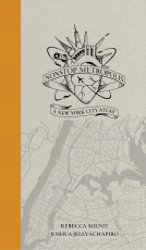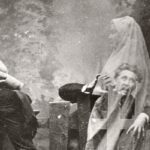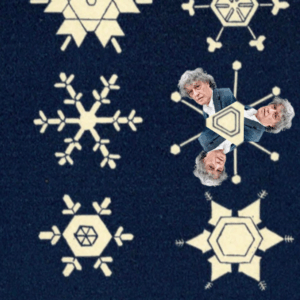
Wu-Tang's RZA on the Mysterious Land of Shaolin: Staten Island
Joshua Jelly-Schapiro Talks to a Hip-Hop Icon About His Island Youth
The following appears in Nonstop Metropolis, by Rebecca Solnit and Joshua Jelly-Schapiro.
To speak of the geography of any place is to invoke at least two distinct senses of the word. The first sense is literal—the concrete roads and rivers or hills, the bits of location and soil, that comprise that spot on the earth’s skin. The second is more meta—it refers to what’s suggested by the etymology of “geography” (geo-graph—“to write the world”): it adheres less to earthly places than to how we represent them. The “geography” of a place, in this sense, is comprised of the maps we make of it, notably, but also of songs and stories that evoke it. And this geography can be every bit as important to how we imagine a place, or form our myriad attachments to it, as its pavements or its air.
That’s one of the ideas guiding Nonstop Metropolis, the atlas of New York City that I co-edited with Rebecca Solnit. And it’s the basis for a map that charts New York’s least understood borough—Staten Island—through how Staten Island has been potently reimagined, even as it remains a place as well known as a home to cops than hip-hop, by its best-known modern cultural export: the Wu-Tang Clan.
The storied troupe of rappers-cum-conceptual artists who emerged from the Stapleton and Park Hill housing projects in Staten Island, after “forming like Voltron” around their leader, RZA, in the early 1990s, has been a cultural force ever since. But perhaps nowhere has the Wu’s imagination and impact been so deeply felt as in their home borough—a place which you’d think is separated from the rest of New York City by far more than a bay, given how the two sides—and it does feel like only two sides—speak of each other.
Most New Yorkers, if they can be bothered to have a view of Staten Island, contend that it’s a sleepy, insular borough that is so not worth the effort exploring—that when people get off the ferry-ride past the Statue of Liberty, they should just turn around, their backs to the borough. Staten Islanders argue that the rest of the city is a bunch of parochial bellyachers who have not taken the time to get to know Staten Island.
Riding the Staten Island Ferry to Manhattan, a young Robert Diggs (the future RZA) frequented old grindhouse movie theaters around Times Square to see kung fu movies—including “Shaolin and Wu Tang”—that came to dominate his imagination, along with that of his cousins and friends. Renaming their island “Shaolin,” RZA and his cohorts went on, whether by rapping about “Shaolin,” or Manhattan (“Mecca,” in their nomenclature), or Brooklyn (“Medina”), or New Jersey (“New Jerusalem”), to find ways to both celebrate and be critical of their home, bringing their varied personas, ferocious beats, and nimble rhymes to bear on topics that range from poverty to philosophy to violence to video games. On the way, they have won widespread adoration but also have given homage to Staten Island’s Chinese Americans, whose contributions to that borough have been and continue to be invaluable—well beyond inspiring music that breaks the divides between Staten Island and elsewhere. In The Wu-Tang Manual, RZA wrote that “some old myths and old stories have reality inside them.” For Nonstop Metropolis, and for our map “The Mysterious Land of Shaolin,” I spoke with RZA—islander, abbot, mensch—about Staten Island, then and now, and the realities behind his myths.
–Joshua Jelly-Schapiro
Joshua Jelly-Schapiro: You grew up between Staten Island and Brooklyn; you lived in public housing in both boroughs. But by your teens you were in Staten Island pretty full time. How did Staten Island compare to Brooklyn in those days, when you were growing up? What do you remember of each?
RZA: One thing about Staten Island that was different from Brooklyn was the ability to walk from one neighborhood to another, to actually have a break from project life. For instance, in Brownsville, in Brooklyn, if I walked from the Marcus Garvey projects to go see my cousin Vince, who lived in the Van Dyke projects, I had to walk through four projects to get there—and each project could be considered “turf.” In fact each building could be considered turf. But on Staten Island, you can walk from the Park Hill projects to the Stapleton projects, and in between those two projects is something else—“normal” hardworking homeowners, you know. Not projects. When I was on Staten Island I walked a lot—I’d walk from Park Hill to Stapleton, and then from Stapleton to New Brighton. I would take the route that led up Targee Street, make the right down Van Duzer, and then take Cebra. And on Cebra and on Van Duzer, I saw what we’d consider mansions then, big homes. And I think seeing another side of life, that wasn’t ghetto life—I think there was something healthy about that. When I was living in Staten Island in sixth grade, when a snowstorm happens, guess what I’m able to do—I’m able to get out, pull out a shovel, and make $15 hustling, shoveling snow. That wasn’t available in Brownsville. You had breathing space. You were able to walk a few blocks, not worried about fighting, defending, stealing, robbing—things that happen every day in the projects.
JJS: You write in your book, The Tao of Wu, about how important it was to you, later on, to be from an island—that somehow that bred a different mentality, a different sense of things in the city.
RZA: Well, we were isolated from the other boroughs—and let’s add Jersey to that as well, because Staten Island is in between Brooklyn and New Jersey. So Staten Island was the type of place that had its own style; where our slang became isolated; we had our own thing. It was a fusion of the other boroughs, but it grew into its own thing. When I was seventeen or eighteen years old, we’d go out to nightclubs in the city—the Red Parrot, Latin Quarter, Union Square. People from Staten Island, from different projects, heading to Manhattan. And even though we were fighting each other on Staten Island, when we got to Manhattan, or to a Brooklyn club or to a Jersey club, we all united. I remember having big fights in clubs and seeing guys from West Brighton or from Mariner’s Harbor, who had enemies in Park Hill—but it was cool, you know. We all fought like The Warriors trying to come home. [laughs]
JJS: You like that quote about how “only on a remote island can something like King Kong grow to his full capacity.” Does that resonate for you in terms of the Wu-Tang Clan, coming from the island you came to call Shaolin?
RZA: Yeah, definitely. Because being isolated, being away from what the rest of the city was doing, changing things up every few weeks, we were able to develop our own thing. And when we brought it to the world, it basically felt unknown to them. To get off Staten Island, you have to get on that ferry, unless you have a vehicle. So a lot of young people, they don’t leave the island. There’s a lot of guys that could have been on that block for eight years and never left.
JJS: So when you started going in to 42nd Street to watch kung fu movies as a kid, you were going on the Staten Island ferry?
RZA: For sure, bus ride to the ferry. Or you could take a van to the ferry, a “dollar van”—they cost a dollar. Either way, you go across on the ferry. Then you catch the 1 train at Chambers Street, cross over to the 2 or the 3 express—and, done: you hit 42nd Street. Or you could walk up to Bowling Green and jump on the 4, or take the R. But ferry was the way.
And one cool thing about the ferry boat, when I was brought up, is that the ferry rugged. It had three levels. The bottom level was where the cool hip-hop kids hung out, the black kids. And they were selling loose joints on the boat. You could buy a joint on the bottom of the boat; you could smoke it outside. You also could get beat up down there. Coming home from the city, all the late-night ruffians of Staten Island are on there—everybody had to come home on that ferry.
JJS: You’ve said that the first time you went to 42nd Street was in 1978. You were nine; your cousin Vince took you to see kung fu flicks. What do you remember about those grindhouse theaters there in those days? What was the scene like?
RZA: Well, you know I really went for years, so over an eight-year period, the vibe changed. It started off that the places we went, the bigger theaters, were spots where multicultural movies and blaxploitation were shown. But the street was filled with thieves and hustlers, heroin addicts, people sniffing glue. Many people from around the city were migrating to those theaters because they were cheap—you’d get three films for $1.50. The whole day. A heroin addict could sit there and shoot up all day; glue sniffers, too. Or a truant kid like me. The first showing was usually at 10 or 10:30 am. You’d get in there and you could stay until 5:00 o’clock—and hey, there goes your class for the day. [laughs]
As the years went by, it turned into more and more of a porno capital. Before, it was the ones closer to Eighth Avenue that mainly showed porno. Some of the theaters showed both Hong Kong movies and porno. But later in the 80s those big theaters all became porno theaters; the smaller theaters that were porno theaters became the kung fu theaters. So it switched up. But prostitution was always big; there were a lot of hookers. Peep shows were everywhere, in between the theaters. And it wasn’t until Disney came and bought all that shit up that it was cleaned up.
JJS: So tell me about the first films on 42nd Street that really hit you—you’ve spoken, for example, about the Shaw Brothers’ Five Deadly Venoms, a film about kung fu fighters with five different animal styles.
RZA: Yeah, well, that was one that really took my imagination past basic. I mean, before I saw Five Deadly Venoms, Star Wars was my favorite film—but then Five Deadly Venoms, really, that was important all through my young adult years, developing into a teenager. There were others too. A film called Fearless Fighters—that’s the first film where a woman puts a kid on her back and then jumps across the lake. [laughs] I’d never seen anything like that. You’ve been watching American films your whole life and then you watch this fucking lady fly across the lake and she’s not Superman? But seeing Five Deadly Venoms just sparked my imagination—I’d read a book called The Five Chinese Brothers. And seeing that film changed my imagination; it just resonated with me, at a high level.
JJS: Later in your teens, I know you were bringing VHS tapes back to Staten Island, hosting screenings of these movies for people in your home. You’ve said that one of those movies in particular, The Eight Diagram Pole Fighter, really moved people—that it was “a reflection of the reality we were all living.” How so? Why did people in the projects connect to these films in that way?
RZA: When it came to The Eight Diagram Pole Fighter, I think what made that so resonant was that it was a story about brotherhood—about brothers fighting for each other, dying, a family being destroyed by betrayal, seeking revenge and redemption, and war in which even the females have to get involved. But there was something else, too. Films like The 36th Chamber, for example, show government oppression—they show a foreign government oppressing the local people. You see people defending their nationality, joining the revolution. And in the projects we were babies of the 1960s-70s revolution. Dr. King and Malcolm X—these ideologies are in our homes. In pictures and magazines that represent that time, album covers, Gil Scott-Heron. So to see another version of these things resonated with us. When Ghost[face Killah] and I saw Eight Diagram Pole Fighter we were probably sixteen years old. And that film just struck a nerve of brotherhood in us.
JJS: So these kung fu movies, these narratives and images are really resonating with you, but what was your exposure to other forms of Chinese culture, to Chinese people in the city, as a kid?
RZA: Well, the thing about New York, they still call it a melting pot for a reason. Think about this: I can say that from the age of eleven to thirteen, two of me and Dirty’s [Ol’ Dirty Bastard’s] best friends were “Kimbo” and Lee—these two Chinese guys who lived upstairs in the project. And when their mother found out that we were kung fu fanatics, she would take us on Sundays to Chinatown to their theaters there—they actually offered the first-run movies, unlike the second-run stuff in Times Square. We had to read the subtitles; they had a great theater down there, off the Bowery.
So that kind of energy, that Chinese culture was also in our neighborhood. There were Asian brothers in our schools, Asian brothers in our buildings, so we had that energy. But then also, you know, as hip-hop was growing, there were also kids just trying to be what hip-hop represented—which was a guy with a nice three-finger gold ring, gold cables on his neck. But we had to go to Chinatown to get the gold. All the gold you’d see everybody wearing, you know, from 1986, ’87, ’88—that’s Chinatown gold!
Everybody went there for it—you get some money, you hustle, you went down to Chinatown to get your gold. Gold teeth! If you wanted gold teeth you had to go to Chinatown. It wasn’t until maybe ’89 that Albee Square Mall in Brooklyn picked up on it and different nationalities started entering the gold market, opening up jewelry shops in downtown Brooklyn, Aqueduct in Queens, up in the Bronx on Fordham Road. But Canal Street [in Chinatown] was the first place in my life growing up to see the gold and gold teeth—you had to get on that train and go down to Chinatown.
JJS: So as hip-hop really flourished in New York, it of course wasn’t Staten Island where it really jumped off. I know you’ve written about being turned onto hip-hop by people from there like DJ Jones—but what was it like coming up in hip-hop from Staten Island? Were people from the Bronx and Harlem and Brooklyn skeptical? Do you feel like you had to fight a little harder?
RZA: I don’t think it affected me personally, but certainly some of that existed. There was a song that came out by a group called Divine Sounds in the 80s. They were from Bed-Stuy [in Brooklyn]. It went: “Manhattan makes it / Brooklyn takes it / Queens is the wack / Staten Island stupid smiling / the Bronx is bugging out on crack / We from Brooklyn . . . ” That didn’t go well with us—“Staten Island stupid smiling”?! But being an MC who had a chance to go all over the five boroughs, I would trek out on trains to anywhere—I mean, I lived on Staten Island, but I would cut school fifth period to go to the Bronx to battle a motherfucker. That’s how serious I was about hip-hop. But I think when Wu-Tang started performing there was definitely an extra bit of aggression to let niggas know—yeah, Staten Island. A little chip on the shoulder.
JJS: You got the chance, after Wu-Tang Clan made it, after you became successful, to actually go to China, to visit the Wudang Mountains and the original Shaolin temple. What was that like?
RZA: It was, to put it simply, an enlightening experience. It felt like a pilgrimage for me. I will never forget the Abbot of Wu Tang and my people from Shaolin telling me they already knew that I was going to come there. The Abbot of Wu Tang recognizing me, telling me that I am the Abbot of the West.
The best analogy is a seed that grows into a tree, whose seeds are scattered around the world. One seed can produce an orchard. But all orchards have a root. And for me Mount Song was the root, Wudang Mountain was the root, and I was able to go back to the root of it all. And there I was also able to clean out some myths that existed in my head, too—I learned that some of the movies that I watched, that I loved, were actually based on old literature, not old facts. I learned that Eight Diagram Pole Fighter is a real story that has been literature-ized, in different ways. The story about how the women went out because all the men were killed, that may have been for the film. But the story of the [soldiers] being betrayed by their own general and the father and many of the brothers dying in the battle—that’s a famous piece of Chinese history from the Song dynasty, and one of the most popular operas. So in The Man with the Iron Fists [the kung fu movie RZA directed in 2012], I had a small scene of opera performers going on the stage of the Dragon Inn; it was that same story from Eight Diagram.
JJS: Talk about bringing things full circle. Tell me about that experience—what was it like to direct your own kung fu flick?
RZA: It was a true blessing, a true culmination of something that began for me as a young kid. It was one of the most fulfilling things creatively that I’ve done. Of course the Wu-Tang Clan is the foundation of my creative expression. Growing up on Staten Island and living in New York, being a New Yorker—that molded me into the man I am. But making Man with the Iron Fists gave me a chance to fulfill a childhood dream. You think about songs like “Wu-Tang Clan Ain’t Nuthing Ta Fuck Wit” or “Shaolin vs. Wu-Tang,”—those sound bites at the beginning: “Shaolin shadowboxing, and the Wu-Tang sword style! / If what you say is true, the Shaolin and the Wu-Tang could be dangerous . . . ” Well, those actors who were dubbed for those sound bites—they’re in my movie! Gordon Liu [from, for instance, The 36th Chamber of Shaolin]. Ka-Yan Leung from Two on the Road—they’re in my movie. So to be able to bring that talent back—it definitely put a lot in perspective. Just like being able to grow up, as a musician, to come from Staten Island listening to music produced by Quincy Jones and, you know, Isaac Hayes—and to get to grow up and work with them, it’s a blessing.
JJS: How do you think Staten Island has changed since you grew up there?
RZA: I think Staten Island kind of retains a lot more of New York than a lot of other places—it’s changed less. I did a film there last summer. And some of the stores you go in there, the vendors still sound like real old New Yorkers, you know, unfiltered. In my generation there was a very strong divide between white and black. We actually had riots in New Dorp High School. There was a part of Staten Island called Rosebank where the blacks couldn’t go without being chased. The white boys couldn’t come to Park Hill unless they were buying crack. If they came to buy crack they could get robbed also. It was very racially charged. We overcame some of that during the Wu-Tang era. It is different now for young people.
JJS: Did what happened to Eric Garner surprise you? His killing by police here, for selling loose cigarettes, galvanized the #BlackLivesMatter movement.
RZA: The incident was heartbreaking to me. It happened right where we filmed our video Can It Be. It was right there, right on that location. For us, who came out of Staten Island and who have tried to be a positive force of inspiration, to prove that there’s hope for high school dropouts—it was heartbreaking. To see Eric Garner doing what is so normal, selling loose cigarettes—just like people on the ferry boat used to sell loose joints. I used to get arrested for selling weed. And to see him lose his life for selling cigarettes? It is tragic. But it’s a bad reflection less of the evolution of Staten Island than of certain police—of how they view their citizens that they vow to serve and protect. That law enforcement issue is not something that’s just confined to Staten Island; it’s an issue around our country.
JJS: You spoke after the incident, about how it wasn’t just the one cop who should have been indicted, but all of them in that situation. You said, “Those are the guys who give us the non-value of black life.”
RZA: Yeah. I mean, that is what happened—a total devaluation. But look, I have so much respect for the police department. Some of my buddies are cops. I was in high school in Staten Island, so I know guys that joined the force there. Some guys took the Wall Street route, I went to entertainment; but some of us are still buddies with each other. My first girlfriend is a cop! I know there’s a lot of good people there. But seeing that we as a city didn’t take heed of what we saw, that these police didn’t see an injustice there—that was tragic.
When I saw the Eric Garner video footage, I flashed back to Rodney King. It was on the day that the King trial ended, when those police were acquitted, that’s when ODB [Ol’ Dirty Bastard] caught his first big assault case. We all got drunk that night. We all were pissed off, and ODB actually physically damaged somebody that night. He had to go to court; it was something that stained his record. We went too far, we emotionally reacted. But the thing about Rodney King—when you look at that videotape, it’s shot from, like, fifty feet away. It’s poor quality, it’s dark. It’s a grainy tape. Maybe in court you could argue that the jury couldn’t see what we saw. But with Eric Garner—the shit is HD; it’s clear. Right in your face; 3D, almost. And the system didn’t feel that there was an injustice there. That was the thing that shook me up the most, for Staten Island, for the city. Because regardless of what the officers are saying and what we understand they’re saying, the physical, visible evidence is in our face. It’s in our face. So some things haven’t changed. Maybe they will change. We’re seeing more and more of the cameras in cop cars; everybody has their cell phones. When we were kids we heard that Big Brother’s watching. Well, Big Brother is watching now. And hopefully we’ll do the right thing, as Spike Lee once said.
From NONSTOP METROPOLIS. Used with permission of University of California Press. Copyright 2016 by Rebecca Solnit and Joshua Jelly-Schapiro.
Joshua Jelly-Schapiro
Joshua Jelly-Schapiro is the author of "Island People: The Caribbean and the World" (Knopf/2016) and the co-editor, with Rebecca Solnit, of "Nonstop Metropolis: A New York City Atlas" (California/2016). He earned his PhD in geography at UC-Berkeley, and is currently a visiting scholar at the Institute for Public Knowledge at NYU. He's also @jellyschapiro




















